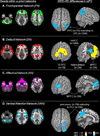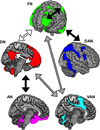Large-Scale Network Dysfunction in Major Depressive Disorder: A Meta-analysis of Resting-State Functional Connectivity
- PMID: 25785575
- PMCID: PMC4456260
- DOI: 10.1001/jamapsychiatry.2015.0071
Large-Scale Network Dysfunction in Major Depressive Disorder: A Meta-analysis of Resting-State Functional Connectivity
Abstract
Importance: Major depressive disorder (MDD) has been linked to imbalanced communication among large-scale brain networks, as reflected by abnormal resting-state functional connectivity (rsFC). However, given variable methods and results across studies, identifying consistent patterns of network dysfunction in MDD has been elusive.
Objective: To investigate network dysfunction in MDD through a meta-analysis of rsFC studies.
Data sources: Seed-based voxelwise rsFC studies comparing individuals with MDD with healthy controls (published before June 30, 2014) were retrieved from electronic databases (PubMed, Web of Science, and EMBASE) and authors contacted for additional data.
Study selection: Twenty-seven seed-based voxel-wise rsFC data sets from 25 publications (556 individuals with MDD and 518 healthy controls) were included in the meta-analysis.
Data extraction and synthesis: Coordinates of seed regions of interest and between-group effects were extracted. Seeds were categorized into seed-networks by their location within a priori functional networks. Multilevel kernel density analysis of between-group effects identified brain systems in which MDD was associated with hyperconnectivity (increased positive or reduced negative connectivity) or hypoconnectivity (increased negative or reduced positive connectivity) with each seed-network.
Results: Major depressive disorder was characterized by hypoconnectivity within the frontoparietal network, a set of regions involved in cognitive control of attention and emotion regulation, and hypoconnectivity between frontoparietal systems and parietal regions of the dorsal attention network involved in attending to the external environment. Major depressive disorder was also associated with hyperconnectivity within the default network, a network believed to support internally oriented and self-referential thought, and hyperconnectivity between frontoparietal control systems and regions of the default network. Finally, the MDD groups exhibited hypoconnectivity between neural systems involved in processing emotion or salience and midline cortical regions that may mediate top-down regulation of such functions.
Conclusions and relevance: Reduced connectivity within frontoparietal control systems and imbalanced connectivity between control systems and networks involved in internal or external attention may reflect depressive biases toward internal thoughts at the cost of engaging with the external world. Meanwhile, altered connectivity between neural systems involved in cognitive control and those that support salience or emotion processing may relate to deficits regulating mood. These findings provide an empirical foundation for a neurocognitive model in which network dysfunction underlies core cognitive and affective abnormalities in depression.
Conflict of interest statement
No part of this study constitutes a conflict of interest for the corresponding author or coauthors.
Figures


References
-
- Substance Abuse and Mental Health Services Administration S. Results from the 2012 National Survey on Drug Use and Health: Mental Health Findings. Rockville, MD: Substance Abuse and Mental Health Services Administration; 2013.
-
- World Health Organization W. World Health Statistics. Geneva, Switzerland: WHO Press; 2010.
Publication types
MeSH terms
Grants and funding
LinkOut - more resources
Full Text Sources
Other Literature Sources
Medical

